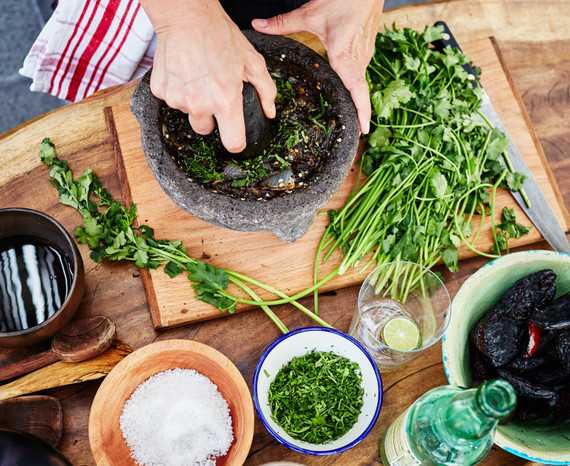For Bon Appétit, by Rick Martinez.
Yes, everybody makes basic cooking mistakes. Like, say, something as simple as overcooking mushrooms or toasting grains and spices. Below, reader Glen confesses his poorly washed salad greens to senior food editor Rick Martinez. Welcome to Effed it Up.
Dear Rick,
I thought I was being a good team player by offering to bring a salad to my friend's summer cookout. But when we started eating it later that day, it was gritty, sandy, and gross. I really thought I was going to chip a tooth on a stray pebble. I rinsed the greens like I thought I was supposed to--so where did I go wrong?
Thanks,
Glenn
Dear Glenn,
You're making my teeth hurt just thinking about it. I learned this lesson the hard way. When I first graduated culinary school, I worked the garde manger station at a farm-to-table restaurant in New York. At the height of summer, I was responsible for 12 salads on the menu--in other words, I had a boatload of greens to wash and prep. Every morning before service, Chef would inspect all the greens. If they weren't up to his standards, I was sent to the basement to rewash. You do not want to be sent to the basement. Which is to say, I think there's an easy fix for your gritty greens.
Cold Bath
The easiest way to clean your greens is to agitate and soak them in a large quantity of water. At the restaurant, that meant filling 10-gallon sinks with cold water to soak 20 heads of lettuce at a time. At home, just fill a large bowl or your kitchen sink. Separate the greens and add them to that large quantity of cold water.
The Washing Machine Swirl
Vigorously swirl the water and agitate the greens. You want the moving water to shake the dirt out of the nooks and crannies in the leaves. If you get your greens from a farmers' market, chances are there will be a lot more dirt clinging to them. Make sure to really inspect a few of the leaves, checking for patches of caked-on dirt. If you are washing whole heads of greens, dunk the heads and gently open them up, bending the leaves away from the core to allow water to get in between the leaves and remove the dirt stuck down at the core. Also look for dirt in the hidden "elbow," the area where leaves attach to the stem.

Baby romaine and hot smoked salmon salad. Photo: Peden + Munk
Gravity Is Your Friend
Pour yourself a drink and let gravity do the work for you. Walk away and let dirt settle to the bottom of the bowl or sink. Wait about 10 minutes, then lift the greens out of the water without disturbing the dirt about the bottom. Give the greens a gentle shake to get the excess water off.
The Salad Spinner
The number one rule of salad spinning is not to overload the salad spinner. You will never get the water out if you do. If your greens are too large to fit in the spinner, cut or break them into pieces. Once spun, spread the greens out on a towel or paper towel-lined sheet tray and pat down with additional towels or paper towels.

Iceberg with tomatoes, blue cheese, and bacon. Photo: Alex Lau
Whole, Intact Heads? Do Not Spin
If you are cleaning intact, whole heads of greens (maybe you're going to grill them!), do not try to shove them into a salad spinner. Instead, wrap a head in a dry kitchen towel and shake over the sink. The towel will absorb water as you shake. If you're feeling adventurous, go outside and, with a firm grip on the towel wrapped greens, swing your arm in a circle (like you're wielding a medieval flail) and spin the greens. If your greens sporadically shoot out water like a sprinkler in the yard, you're doing it right. Once spun, wrap the greens in a paper towel and place upside down on a rimmed baking sheet to allow any trapped water to collect at the bottom of the tray.
Storage
If you are not using your greens immediately, store them in the refrigerator in large zip-top freezer bags with a folded, dry paper towel in the bag. The paper towel will absorb any excess moisture and keep the greens from getting waterlogged. That same paper towel will also re-hydrate your greens if you are storing them for more than one day.
Now that is how you clean greens and avoid being sent to the basement.
Love,
Rick
More from Bon Appetit:
31 Boneless, Skinless Chicken Breast Recipes That Are NOT Boring
Our 50 Favorite Weeknight Dinners

